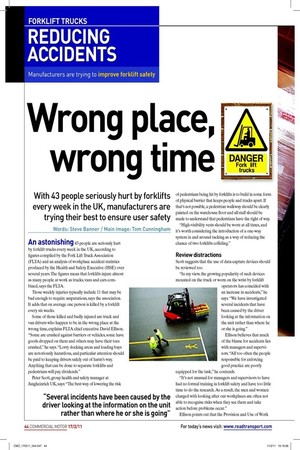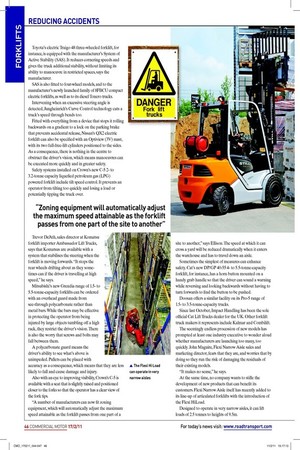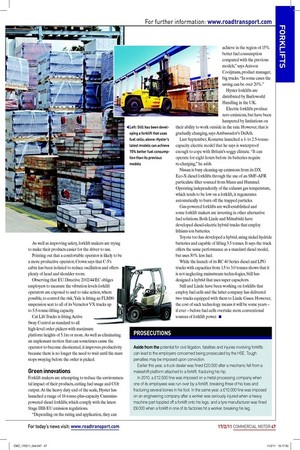Wrong place, wrong time
Page 37

Page 39

Page 40

If you've noticed an error in this article please click here to report it so we can fix it.
With 43 people seriously hurt by forklifts every week in the UK, manufacturers are trying their best to ensure user safety
Words: Steve Banner / Main image: Tom Cunningham An astonishing 43 people are seriously hurt by forklift trucks every week in the UK, according to igures compiled by the Fork Lift Truck Association (FLTA) and an analysis of workplace accident statistics produced by the Health and Safety Executive (HSE) over several years. The igures mean that forklifts injure almost as many people at work as trucks, vans and cars combined, says the FLTA.
Those weekly injuries typically include 11 that may be bad enough to require amputations, says the association. It adds that on average one person is killed by a forklift every six weeks.
Some of those killed and badly injured are truck and van drivers who happen to be in the wrong place at the wrong time, explains FLTA chief executive David Ellison. “Some are crushed against barriers or vehicles, some have goods dropped on them and others may have their toes crushed,” he says. “Lorry docking areas and loading bays are notoriously hazardous, and particular attention should be paid to keeping drivers safely out of harm’s way. Anything that can be done to separate forklifts and pedestrians will pay dividends.” Peter Scott, group health and safety manager at Jungheinrich UK, says: “The best way of lowering the risk of pedestrians being hit by forklifts is to build in some form of physical barrier that keeps people and trucks apart. If that’s not possible, a pedestrian walkway should be clearly painted on the warehouse loor and all staff should be made to understand that pedestrians have the right of way.
“High-visibility vests should be worn at all times, and it’s worth considering the introduction of a one-way system in and around racking as a way of reducing the chance of two forklifts colliding.”
Review distractions
Scott suggests that the use of data-capture devices should be reviewed too.
“In my view, the growing popularity of such devices mounted on the truck or worn on the wrist by forklift operators has coincided with an increase in accidents,” he says. “We have investigated several incidents that have been caused by the driver looking at the information on the unit rather than where he or she is going.” Ellison believes that much of the blame for accidents lies with managers and supervisors. “All too often the people responsible for enforcing good practice are poorly equipped for the task,” he contends.
“It’s not unusual for managers and supervisors to have had no formal training in forklift safety and have too little time to do the research. As a result, the men and women charged with looking after our workplaces are often not able to recognise risks when they see them and take action before problems occur.” Ellison points out that the Provision and Use of Work Toyota’s electric Traigo 48 three-wheeled forklift, for instance, is equipped with the manufacturer’s System of Active Stability (SAS). It reduces cornering speeds and gives the truck additional stability, without limiting its ability to manoeuvre in restricted spaces, says the manufacturer.
SAS is also itted to four-wheel models, and to the manufacturer’s newly launched family of 8FBCU compact electric forklifts, as well as to its diesel Tonero trucks.
Intervening when an excessive steering angle is detected, Jungheinrich’s Curve Control technology cuts a truck’s speed through bends too.
Fitted with everything from a device that stops it rolling backwards on a gradient to a lock on the parking brake that prevents accidental release, Nissan’s QX2 electric forklift can also be speciied with an Optiview (3V) mast, with its two full-free-lift cylinders positioned to the sides. As a consequence, there is nothing in the centre to obstruct the driver’s vision, which means manoeuvres can be executed more quickly and in greater safety.
Safety systems installed on Crown’s new C-5 2to 3.2-tonne capacity liqueied petroleum gas (LPG) powered forklift include tilt speed control. It prevents an operator from tilting too quickly and losing a load or potentially tipping the truck over.
Trevor De’Ath, sales director at Komatsu forklift importer Ambassador Lift Trucks, says that Komatsus are available with a system that stabilises the steering when the forklift is moving forwards. “It stops the rear wheels drifting about as they sometimes can if the driver is travelling at high speed,” he says.
Mitsubishi’s new Grendia range of 1.5to 5.5-tonne-capacity forklifts can be ordered with an overhead guard made from see-through polycarbonate rather than metal bars. While the bars may be effective in protecting the operator from being injured by large objects tumbling off a high rack, they restrict the driver’s vision. There is also the worry that screws and bolts may fall between them.
A polycarbonate guard means the driver’s ability to see what’s above is unimpeded. Pallets can be placed with accuracy as a consequence, which means that they are less likely to fall and cause damage and injury.
Also with an eye to improving visibility, Crown’s C-5 is available with a seat that is slightly raised and positioned closer to the forks so that the operator has a clear view of the fork tips.
“A number of manufacturers can now it zoning equipment, which will automatically adjust the maximum speed attainable as the forklift passes from one part of a site to another,” says Ellison. The speed at which it can cross a yard will be reduced dramatically when it enters the warehouse and has to travel down an aisle.
Sometimes the simplest of measures can enhance safety. Cat’s new DP/GP 40-55 4to 5.5-tonne-capacity forklift, for instance, has a horn button mounted on a handy grab handle so that the driver can sound a warning while reversing and looking backwards without having to turn forwards to ind the button to be pushed.
Doosan offers a similar facility on its Pro-5 range of 1.5to 3.5-tonne-capacity trucks.
Since last October, Impact Handling has been the sole oficial Cat Lift Trucks dealer for the UK. Other forklift truck makers it represents include Kalmar and Combilift.
The seemingly endless procession of new models has prompted at least one industry executive to wonder aloud whether manufacturers are launching too many, too quickly. John Maguire, Flexi Narrow Aisle sales and marketing director, fears that they are, and worries that by doing so they run the risk of damaging the residuals of their existing models.
“It makes no sense,” he says.
At the same time, no company wants to stile the development of new products that can beneit its customers. Flexi Narrow Aisle itself has recently added to its line-up of articulated forklifts with the introduction of the Flexi HiLoad.
Designed to operate in very narrow aisles, it can lift loads of 2.5 tonnes to heights of 9.5m. As well as improving safety, forklift makers are trying to make their products easier for the driver to use.
Pointing out that a comfortable operator is likely to be a more productive operator, Crown says that C-5’s cabin has been isolated to reduce oscillation and offers plenty of head and shoulder room.
Observing that EU Directive 2002/44/EC obliges employers to measure the vibration levels forklift operators are exposed to and to take action, where possible, to control the risk, Yale is itting an FLM80 suspension seat to all of its Veracitor VX trucks up to 5.5-tonne-lifting capacity.
Cat Lift Trucks is itting Active Sway Control as standard to all high-level order pickers with maximum platform heights of 5.1m or more. As well as eliminating an unpleasant motion that can sometimes cause the operator to become disoriented, it improves productivity because there is no longer the need to wait until the mast stops swaying before the order is picked.
Green innovations
Forklift makers are attempting to reduce the environmental impact of their products, cutting fuel usage and CO2 output. At the heavy duty end of the scale, Hyster has launched a range of 16-tonne-plus-capacity Cumminspowered diesel forklifts, which comply with the latest Stage IIIB EU emission regulations.
“Depending on the rating and application, they can achieve in the region of 15% better fuel consumption compared with the previous models,” says Antoon Cooijmans, product manager, big trucks. “In some cases the saving can be over 20%.” Hyster forklifts are distributed by Barloworld Handling in the UK.
Electric forklifts produce zero emissions, but have been hampered by limitations on their ability to work outside in the rain. However, that is gradually changing, says Ambassador’s De’Ath.
Last September, Komatsu launched a 1to 2.5-tonnecapacity electric model that he says is waterproof enough to cope with Britain’s soggy climate. “It can operate for eight hours before its batteries require re-charging,” he adds.
Nissan is busy cleaning-up emissions from its DX Eco-X diesel forklifts through the use of an SMF-AFR particulate ilter sourced from Mann and Hummel. Operating independently of the exhaust gas temperature, which tends to be low on a forklift, it regenerates automatically to burn off the trapped particles.
Gas-powered forklifts are well-established and some forklift makers are investing in other alternative fuel solutions. Both Linde and Mitsubishi have developed diesel-electric hybrid trucks that employ lithium-ion batteries.
Toyota too has developed a hybrid, using nickel hydride batteries and capable of lifting 3.5 tonnes. It says the truck offers the same performance as a standard diesel model, but uses 50% less fuel.
While the launch of its RC 40 Series diesel and LPG trucks with capacities from 1.5 to 3.0 tonnes shows that it is not neglecting mainstream technologies, Still has designed a hybrid that uses super capacitors.
Still and Linde have been working on forklifts that employ fuel cells and the latter company has delivered two trucks equipped with them to Linde Gases. However, the cost of such technology means it will be some years – if ever – before fuel cells overtake more conventional sources of forklift power. ■












































